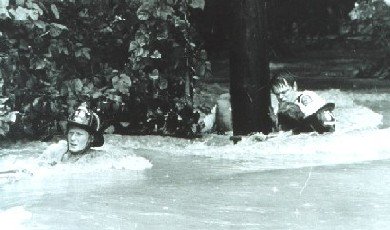|
Flash Floods are a Deceptive and Dangerous Result of Many Storms
Don't let flash floods carry you away - appreciate their power, but go back or around. Particularly treacherous flash floods occur when rain falls well upstream, but not at the location of the flood.Mountain storms directing large water volumes to nearby valleys which may have missed the rain are well known culprits The defining feature is rapidly rising water - at rates of several inches per minute at peak flow. Hazards of Flash Floods Floods are the number one killer in the list of storm related hazards, and most of these deaths result from flash floods. Of these, a large proportion occur when cars are swept off flooded roads - it only takes two feet (60cm) of fast moving water to float a car and sweep it off the road.

Flash flood rescue in progress
For that matter, it only takes 6 inches (15cm) of rapidly flowing water to knock a person off their feet.
Other hazards associated with flash floods are unseen washouts on flooded roads.
So without wishing to overdo the safety aspect, if floodwaters are not obviously falling, it is best to go round rather than through, whether you are driving or on foot.
Observing Flash Floods
In recent years, flash floods have become much more of an urban phenomenon than they used to be. With extensive areas of cement and bitumen in car parks, fully paved roads, and houses with relatively larger roof areas than in the past, far more rain water runs off rather than soaking in.
It can also move away faster - we've all seen roads on hill slopes which almost become rivers during heavy rainfall.
It can be an interesting exercise to track where your storm water goes - your local authority should have plans you can inspect. Somewhere downstream or downslope from you all the runoff from flash floods in your area will come together, sometimes with spectacular results.
Further Information
More
thunderstorm
information can be found at the pages
on
tornadoes,
microbursts and derechos,
hail
and
lightning.
Back to the Top, or return to the Home page. You may be interested to know that you can find out more about weather and home weather stations by receiving our newsletter ,"Watching Weather". It's published more or less weekly, and apart from tips on how to use your weather station and understand what it's telling you about the weather around you, it also covers many other weather related topics. If this sounds interesting, just add your name and email address to the form below. When you join, you'll also receive, totally free, a 20 page guide to setting up and trouble shooting problems in home weather stations. And I promise that you won't get spammed, and that your sign up details will remain totally confidential. Sign up now and receive your first issue almost immediately.
Last update 05/24/2011
|




